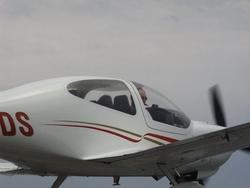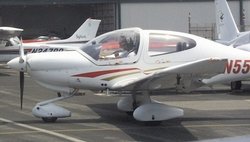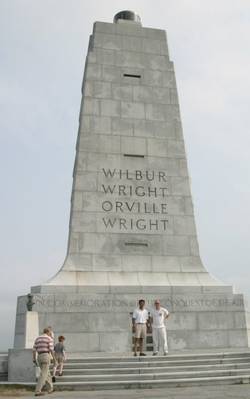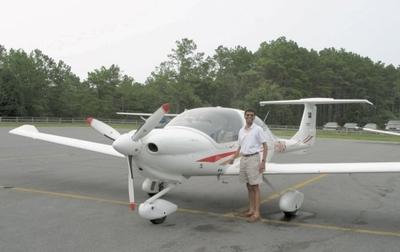Pair in Diamond Bests 2000 Record -- by More Than Double
 When we told you about a new
TransContinental record's having been set last week by a couple
California pilots in a Diamond Star DA-40, we promised to bring you
an interview with the other pilot, the fellow who had this vision
in the first place, Lasken Sirimanne (right). Lasken has just
finished a Master's in Aerospace Engineering, with a concentration
in astronautics, at UCLA. He also has an MBA from Pepperdyne. Next,
he plans to get an Electronics Engineering degree. Oh -- and he has
a three-month-old daughter.
When we told you about a new
TransContinental record's having been set last week by a couple
California pilots in a Diamond Star DA-40, we promised to bring you
an interview with the other pilot, the fellow who had this vision
in the first place, Lasken Sirimanne (right). Lasken has just
finished a Master's in Aerospace Engineering, with a concentration
in astronautics, at UCLA. He also has an MBA from Pepperdyne. Next,
he plans to get an Electronics Engineering degree. Oh -- and he has
a three-month-old daughter.
Lasken, 38, is a US citizen of Sri Lankan origin, and he had
been thinking about making this kind of a record for several years.
He hadn't originally planned on doing it in a Diamond Star, though,
or with a partner. "I started building a gyrocopter in my garage a
few years ago, to do this record. I was planning on doing this --
but I saw it would take about 60 hops."
He has finished his KB3, but he hasn't flown it yet. Ken Brock
himself, who lived nearby, actually helped on some of the details.
Marie (Mrs. Brock), was, he told us, "an angel, so nice, so
helpful." Mrs. Sirimanne is interested, too. "My wife keeps asking
when I'm going to hangar it," he says. Why is she so interested?
"It's parked right next to her car, in the garage."
Plans changed.
Lasken pored over sectionals, studied weather patterns, plotted
routes, for literally over three years. "I just knew I wanted to do
this record," he said. Then, "I saw the Diamond Star -- the specs
were perfect for this record for this record. Not only was it
perfect for the record -- it was at the flight school where I was
training, Sunrise Aviation."
So, "I called Michael Church (owner of Sunrise), and told him I
wanted to do this record. Michael was so kind, and met me before
work one day to go over my idea -- literally at the crack of dawn.
I had a whole bunch of calculations -- I figured the trip wpould
take between 15 and 18 hours." It could have ended right then, but,
Church "...didn't tell me that I was nuts -- he thought it was
quite possible." But why? Well, for one thing, "I have an astronaut
application in at NASA, and I thought it might help me stand out
among the 3200 or so applicants."
 Lasken, who has "about 180
hours in 19 types," told Church, "I didn't want to fly alone -- he
said he had just the person in mind. 'Knowing you, knowing him,' he
said, 'it might make a good combination.'" (Assaf Stoler owns the
plane, and leases it to Sunrise.) Church made the introduction.
Lasken, who has "about 180
hours in 19 types," told Church, "I didn't want to fly alone -- he
said he had just the person in mind. 'Knowing you, knowing him,' he
said, 'it might make a good combination.'" (Assaf Stoler owns the
plane, and leases it to Sunrise.) Church made the introduction.
Mr. Sirimanne said his training was thorough, and knowing that
Assaf trained at Sunrise was exactly the reassurance he needed.
"Sunrise is a phenomomenal flight school," Lasken told us. "We both
trained there, and I was confident in their thoroughness. I was
even able to close my eyes, as Assaf was flying. Knowing what I was
taught, I knew that Assaf was at that level [of thoroughness and
airmanship], as well. The thoroughness is truly a part of Sunrise.
I can't say enough good about their trianing."
That help and understanding didn't end with the introduction,
either. Michael Church was interested, all the way to takeoff. "I
remember Michael Church saying to enjoy the flight. He reminded me
that this wasn't so much about the record -- 'Change the flight
plan, if you need to, stay on the ground if you need to -- just go,
and have a great time, and enjoy the flight,' he said. Thanks to
that in part, we actually had a lot of fun [when we could have been
just worn out]. We had fun."
Experience varies: breadth and depth are complementary.
"Assaf," Sirimanne said, "is IFR rated and commercial; I have
ASEL, seaplanes, and hot air balloons. I'm pretty much a
recreational flier. The trip was planned VFR, but having Assaf
there was a huge help. If the weather looked grimy, we didn't have
to just sit and look up at the sky. We usually could fly."
The plane was the perfect steed for this mission.
 "I've been wanting to do this
coast-to-coast flight for three years," Lasken reminded us. "I
looked at the Archer III and C-172, but now I'm a big Katana fan."
That almost didn't happen. "Assaf had a Liberty XL-2 on order, but
he fell in love with the Diamond Star. Aircraft, planning, and a
little luck really helped us knock the record off."
"I've been wanting to do this
coast-to-coast flight for three years," Lasken reminded us. "I
looked at the Archer III and C-172, but now I'm a big Katana fan."
That almost didn't happen. "Assaf had a Liberty XL-2 on order, but
he fell in love with the Diamond Star. Aircraft, planning, and a
little luck really helped us knock the record off."
Planning? Testing?
"We did a whole lot of test flights," Lasken noted. "We checked
gradual climb, steep climb, best climb at different altitudes,
different cruising altitudes. We were very meticulous." It paid
off. "Actual vs. reality was very close to predition." Assaf also
told us; Lasken reaffirmed: "We were never more than about 10
minutes off, on any leg. We flew at our pre-tested altitudes, fuel
burn, climb rates -- it all came together." Who flew? "I flew left
seat, but Assaf did a lot of takeoffs and landings, from the right
seat. Then we switched on the way back... but there was no
significance to which side we were on... we both flew the airplane.
Actually, most of the time, the airplane flew itself. I did most of
the navigation; Assaf did most of calcualtions."
Surprises?
 "The biggest surprise was
how smoothly things ran." Thorough: "We had been watching the
weather -- I was driving my wife nuts. Weather was bad the day
before we left, and the day after we landed. Everything for the
flight was just right." Even the logistics came out as-planned: "We
landed at Ft Smith (AR) right at midnight, Sparta (TN) at about
4AM. The people who said they'd be there to fuel the plane for us
-- they were there, and on time." It helped that the DA-40 was on
schedule, too.
"The biggest surprise was
how smoothly things ran." Thorough: "We had been watching the
weather -- I was driving my wife nuts. Weather was bad the day
before we left, and the day after we landed. Everything for the
flight was just right." Even the logistics came out as-planned: "We
landed at Ft Smith (AR) right at midnight, Sparta (TN) at about
4AM. The people who said they'd be there to fuel the plane for us
-- they were there, and on time." It helped that the DA-40 was on
schedule, too.
Sometimes, though, the people were 'way beyond "good."
"That guy at Sparta -- he got up at 3AM to come and meet us. He
was there with his flashlight, bringing us in. He had made us
coffee, and was just running around, filling out the paperwork,
doing paperwork, putting the gas in the plane." Controllers, too:
"The controllers -- we told one that we were on a recored run at
Sparta, and he told us to come straight in, keep the squawk code,
and to talk to him when we wanted to go. Everybody -- everybody was
just so totally helpful. Washington Center, even -- he took us all
the way, gave us the time fix -- he gave us distances out: five
miles, three, then, 'Gentlemen, congratulations!' It was 12:50
Zulu."
Would you have done anything differently?
"We would loved to have had the chance to sleep there at Kitty
Hawk -- we waited for our clothes until about 5:30PM [after having
landed just after sunrise --ed]... the Park people fussed over us
like we were celebrities -- they took great care of us. It was hot
and humid... they took us out to eat in their own cars. We looked
for hotels -- height of season, on the shore: no luck... rooms were
all booked, or $400."
To make it perfect, he said, would have taken one more element.
Two, actually... well, four: "It would have been perfect if our
wives were there," he said. "We each have little girls, 3 months
old, born within three days of each other. While we were planning
the flight, we often ended up baby-sitting, with the babies in the
background... sometimes, when we were trying to talk, we had to
figure out how to 'throttle them back!'"
It's still a small cockpit, and twice across the country, with
hardly any sleep...
"Our personalities are very complimentary," he explained.
"Sitting next to each other for seventeen hours, and especially on
the way back, after really no sleep for three days, that
[compatibility] helped a lot. You're right next to each other, in a
very small cockpit."
They did try to get some shuteye, on the way back. They diverted
from plan, after finding no room at the inn, and went to Las Vegas.
"We knew we'd find a room in Las Vegas, right? But there we were,
at 1 in the morning, and all we could find was this terrible [name
of chain deleted --ed.]. The blankets were so dirty, I used three
sheets to keep from touching them. If we had seen it in the
daytime, we wouldn't have even gone in." But they were bushed, and
the four hours' sleep was ultimately refreshing, all things
considered.

So, what was it like?
"This exceed all my expectations -- we were tired, but we had so
much fun," Lasken said. "We planned that one would fly, the other
would sleep... we were both wide-awake nearly the whole time. We'd
both look out and see the beauty... one time, we had this beautiful
moon... we'd look at the stars... we talked about family, what we
are going to do... how we each got to America (Assaf is from
Israel, and has been here 3 years). The combination [of
personalities] was perfect. This flight meant a lot to each of us.
We both enjoyed the planning, the flying... it meant a lot to him,
and it meant a lot to me, too.
 Airbus Racer Helicopter Demonstrator First Flight Part of Clean Sky 2 Initiative
Airbus Racer Helicopter Demonstrator First Flight Part of Clean Sky 2 Initiative Diamond's Electric DA40 Finds Fans at Dübendorf
Diamond's Electric DA40 Finds Fans at Dübendorf ANN's Daily Aero-Term (04.23.24): Line Up And Wait (LUAW)
ANN's Daily Aero-Term (04.23.24): Line Up And Wait (LUAW) NTSB Final Report: Extra Flugzeugbau GMBH EA300/L
NTSB Final Report: Extra Flugzeugbau GMBH EA300/L Classic Aero-TV: 'Never Give Up' - Advice From Two of FedEx's Female Captains
Classic Aero-TV: 'Never Give Up' - Advice From Two of FedEx's Female Captains







